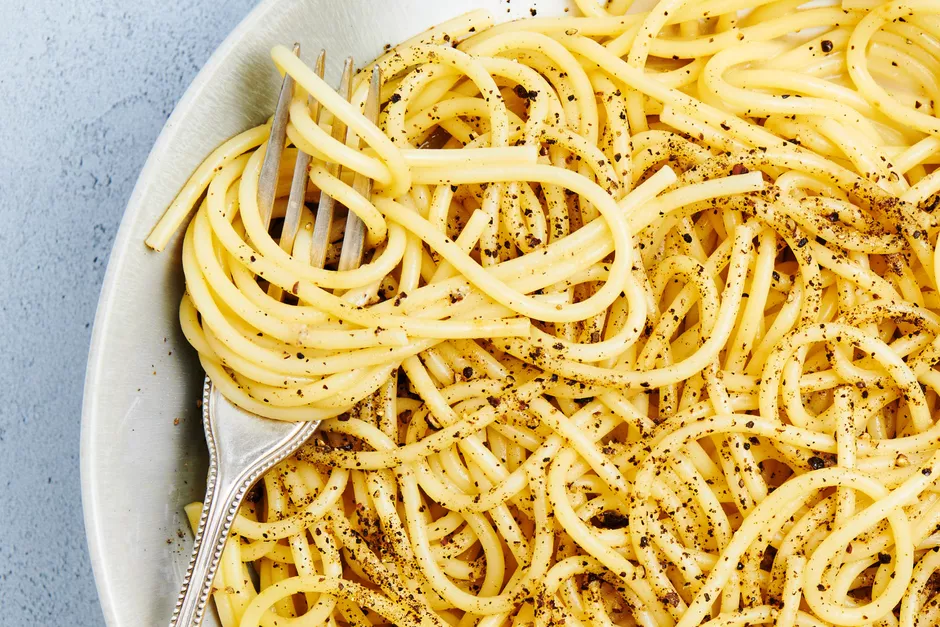I’ve had the privilege of tasting and pairing wines with a wide variety of foods.
One dish that I particularly enjoy pairing with wine is cacio e pepe, a classic Italian pasta dish that features Pecorino Romano cheese and black pepper.
The combination of savory cheese, spicy pepper, and buttery pasta creates a rich and flavorful dish that can be complemented by the right wine.
Whether you prefer red, white, or rosé wines, there are several options that can enhance the flavors of cacio e pepe and create a memorable dining experience.
In this article, I’ll be sharing my top recommendations for the best wines to pair with cacio e pepe.
From classic Italian reds to crisp and refreshing whites, there’s something for every palate and preference.
So, let’s dive in and discover the perfect wine to elevate your next cacio e pepe meal!
But first, what wine goes with Cacio e Pepe?
Some of the best wines to pair with Cacio e Pepe are Chianti, Pinot Grigio, and Riesling. These light-bodied wines will balance out the richness of this classic dish. Other options include Sangiovese or Barbera for a more full-bodied flavor.

Red Wines

When it comes to pairing cacio e pepe with red wines, I usually recommend selecting a wine that has medium to high acidity and moderate tannins.
The acidity can help cut through the rich, creamy flavors of the cheese and pasta, while the tannins can balance out the spiciness of the black pepper.
Here are my top three red wine recommendations for cacio e pepe:
- Chianti Classico: This classic Italian red wine from Tuscany is made primarily from the Sangiovese grape and has a medium body, high acidity, and firm tannins. Its bright red fruit flavors and earthy undertones can complement the saltiness of the Pecorino Romano and the pepperiness of the dish. Chianti Classico is also versatile enough to pair well with other pasta dishes and tomato-based sauces.
- Barbera d’Alba: This red wine from the Piedmont region of Italy is made from the Barbera grape and is known for its high acidity and low tannins. Its fruit-forward flavors of cherry, raspberry, and blackberry can cut through the creaminess of the cacio e pepe and provide a refreshing contrast to the pepper. Barbera d’Alba is also a great choice for those who prefer lighter-bodied red wines.
- Pinot Noir: This red wine from Burgundy, France, is known for its delicate flavors of red fruit, floral notes, and subtle earthiness. Its light to medium body and low tannins can complement the delicate flavors of Pecorino Romano without overpowering them. Pinot Noir is a versatile wine that can also pair well with other cheese-based dishes, such as quiches and fondue.
These red wines can enhance the flavors of cacio e pepe and provide a well-balanced dining experience. Remember to serve them slightly chilled to bring out their flavors and aromas.
White Wines

When it comes to pairing cacio e pepe with white wines, I usually recommend selecting a wine that has high acidity and crisp flavors. The acidity can cut through the richness of the cheese and butter, while the crisp flavors can highlight the saltiness of the Pecorino Romano.
Here are my top three white wine recommendations for cacio e pepe:
- Vermentino: This white wine from Sardinia, Italy, is known for its crisp acidity and refreshing flavors of citrus, green apple, and almond. Its bright acidity can cut through the richness of the cacio e pepe and its nutty flavors can complement the Pecorino Romano. Vermentino is also a great choice for those who prefer lighter-bodied white wines.
- Soave: This white wine from Veneto, Italy, is made from the Garganega grape and is known for its crisp acidity and subtle floral and almond notes. Its light to medium body and citrus flavors can complement the creaminess of the cacio e pepe without overpowering it. Soave is a versatile wine that can also pair well with seafood dishes and risottos.
- Greco di Tufo: This full-bodied white wine from Campania, Italy, is made from the Greco grape and is known for its aromatic and complex flavors of honey, apricot, and minerality. Its bold flavors can stand up to the strong flavors of the black pepper in the cacio e pepe and its acidity can balance the richness of the cheese. Greco di Tufo is a great choice for those who prefer full-bodied white wines.
Rosé Wines

Rosé wines are a great choice for pairing with cacio e pepe because they offer a refreshing balance between the acidity of white wines and the tannins of red wines.
When selecting a rosé wine for cacio e pepe, I usually recommend choosing a dry wine with high acidity and crisp flavors.
Here are my top three rosé wine recommendations for cacio e pepe:
- Cerasuolo di Vittoria: This Sicilian rosé wine is made from a blend of the Nero d’Avola and Frappato grapes and is known for its fruity and floral notes. Its bright acidity can balance the saltiness of the Pecorino Romano and its fruit flavors can complement the spiciness of the black pepper. Cerasuolo di Vittoria is also a great choice for those who prefer fuller-bodied rosé wines.
- Bardolino Chiaretto: This dry rosé wine from Veneto, Italy, is made from the Corvina and Rondinella grapes and is known for its crisp acidity and flavors of red fruit and citrus. Its light body can complement the creaminess of the cacio e pepe and its acidity can cut through the richness of the cheese and butter. Bardolino Chiaretto is also a great choice for those who prefer lighter-bodied rosé wines.
- Rosé d’Anjou: This sweet rosé wine from the Loire Valley in France is known for its fruity and floral flavors and refreshing acidity. Its sweetness can provide a nice contrast to the black pepper in the cacio e pepe and its acidity can balance the richness of the cheese. Rosé d’Anjou is a great choice for those who prefer sweeter rosé wines.
Sparkling Wines

If you’re looking for a more celebratory wine pairing for your cacio e pepe, sparkling wines are a great option. They offer a refreshing and effervescent contrast to the rich and savory flavors of the dish.
Here are my top three sparkling wine recommendations for cacio e pepe:
- Prosecco: This sparkling wine from Veneto, Italy, is known for its crisp acidity and flavors of green apple, honeydew melon, and pear. Its effervescence can provide a nice contrast to the creaminess of the cacio e pepe and its fruity flavors can complement the saltiness of the Pecorino Romano. Prosecco is also a great choice for those who prefer a lighter and sweeter sparkling wine.
- Champagne: This sparkling wine from the Champagne region of France is known for its complexity, richness, and elegance. Its high acidity and bubbles can cut through the richness of the cheese and butter in the cacio e pepe and its delicate flavors of apple, pear, and citrus can complement the dish. Champagne is a great choice for those who prefer a more sophisticated and complex sparkling wine.
- Franciacorta: This sparkling wine from Lombardy, Italy, is made using the traditional method used in Champagne and is known for its elegance, creaminess, and nutty flavors. Its acidity can cut through the richness of the cheese and butter in the cacio e pepe and its effervescence can provide a refreshing contrast to the spiciness of the black pepper. Franciacorta is also a great choice for those who prefer a more complex and full-bodied sparkling wine.
Conclusion
In conclusion, cacio e pepe is a delicious and versatile pasta dish that can be paired with a variety of wines. Whether you prefer red, white, rosé, or sparkling wines, there are several options that can enhance the flavors of the dish and create a well-balanced dining experience.
So, what wine pairs well with cacio e pepe?
Some great wines to pair with Cacio e Pepe are Chianti, Pinot Grigio, and Riesling. Chianti is a classic Italian red that pairs nicely with the salty cheese and pepper flavors of Cacio e Peppe. A light-bodied white like Pinot Grigio also works well as it complements the creamy texture of the dish. Riesling is another good option as its acidity helps cut through the richness of this pasta dish.
When selecting a wine to pair with cacio e pepe, consider the flavors and textures of the dish and choose a wine that can complement or contrast them. For example, a wine with high acidity can cut through the richness of the cheese and butter, while a wine with fruity flavors can complement the spiciness of the black pepper.
Remember to serve your wine slightly chilled and experiment with different wines to find your perfect pairing. With the right wine, cacio e pepe can become an even more enjoyable and memorable dining experience.
Thank you for reading my recommendations for the best wines to pair with cacio e pepe. I hope you found them helpful and enjoyable. Cheers!
Jenny has always been passionate about cooking, and she uses her platform to share her joy of food with others. Her recipes are easy to follow, and she loves giving tips and tricks to help others create their own unique culinary creations.

